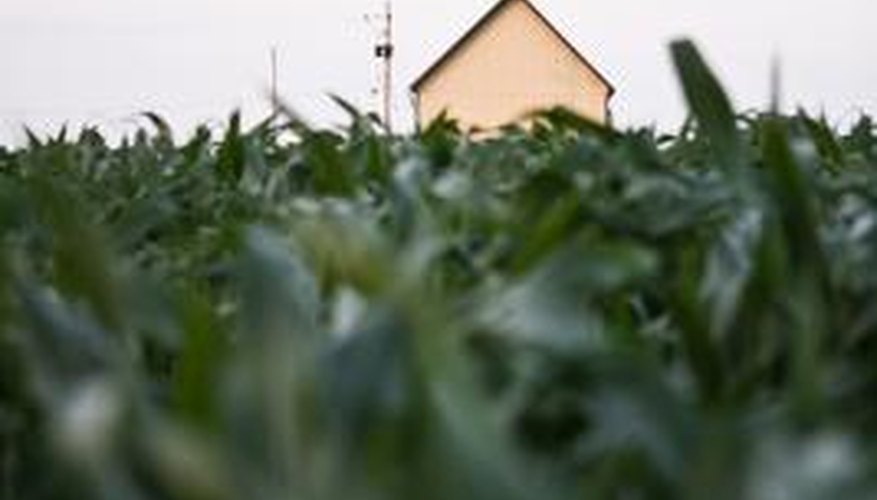Sheds require flooring, roofing and wall materials as well as a door. These three items require framing materials, which are the supports for each area, and facing materials, which is the portion that covers the frame. Hardware and finishing materials are also part of your shed calculations. Buying a little bit of extra material is always a good idea for building projects, just in case you run into trouble, such as warped wood or bent nails.
Determine the length for each wall in inches, and then divide each length by 16, keeping every wall separate at this point. This gives you the number of vertical studs, generally 2- by 4-inch lumber, needed for standard 16-inch spacing. Add two more 2-by-4s to this total for every 8 feet of wall length to get your top and bottom braces for the walls.
- Sheds require flooring, roofing and wall materials as well as a door.
- Add two more 2-by-4s to this total for every 8 feet of wall length to get your top and bottom braces for the walls.
Divide the length of your shed, in inches, by 12 to determine the number of joists for a sturdy floor. Add two joists the same length as your shed width for the end pieces. Joists should be 2-by 6-inch lumber, preferably pressure-treated for durability outdoors.
Add together the area (length x width) for each wall. This is the amount of square footage you will need for facing. Divide the total by 32 (the area of a 4- by 8-foot sheet of plywood) to determine the number of 1/2 or 5/8-inch plywood sheets you need to face the shed. Use the same calculation for the floor, but purchase thicker plywood, such as 3/4 to 1 inch thick.
- Divide the length of your shed, in inches, by 12 to determine the number of joists for a sturdy floor.
- Divide the total by 32 (the area of a 4- by 8-foot sheet of plywood) to determine the number of 1/2 or 5/8-inch plywood sheets you need to face the shed.
Add 1 foot to your shed's width to get the base length for a simple roof truss triangle, and divide your shed's width in half to determine the triangle's height. By this formula, an 8-foot-wide shed would have a triangle 4 feet tall and 9 feet long.
- Add 1 foot to your shed's width to get the base length for a simple roof truss triangle, and divide your shed's width in half to determine the triangle's height.
Divide the triangle base length by 2, and square that and the height measurement. Add these results together and determine the square root of your result. This gives you the length of your roof joist sides. In this case, 9 ÷ 2 = 4.5, so 4.5 squared plus 4 (the height) squared is 36.25. The square root of this is just over 6 feet. Based on this, you would need one 10-foot 2-by-4 and two 8-foot 2-by-4s for each joist.
Multiply the single joist material by the number of joists you need to have one every 16 inches for the length of your shed.
Multiply your number of roof joists by 6 to determine the number of connecting brackets you'll need. Connecting brackets allow you to attach the roof joists together in triangle form without overlapping the wood or driving nails in at awkward angles. Each joist requires a bracket at each of its three corners on both sides of the wood.
Determine the roof area (shed length times triangle side length) and divide the total by 32 to determine the number of 5/8-inch plywood sheets you need to face the roof. Multiply the roof joist base by its height to get your front and back upper facing area, which requires the same type of plywood facing. Use the same area formula you used for roof facing to determine your tar paper and roofing material needs.
- Multiply the single joist material by the number of joists you need to have one every 16 inches for the length of your shed.
- Multiply the roof joist base by its height to get your front and back upper facing area, which requires the same type of plywood facing.
Multiply your roof area's square footage by 10 to estimate the number of staples or other fasteners you will need for tar paper and composite shingles.
Multiply the number of 2-by-4s and 2-by-6s by 6 to approximate the number of 3-inch wood screws you will need to construct the shed.
Multiply the number of plywood sheets by 32 to determine the number of 1 1/2-inch nails or screws you will need to attach the facing.
Add a pre-hung door, doorknob, lock set and any windows you wish to add to your materials list. Also add primer and paint, based on the square footage of your wall facing. Compare this to the paint coverage listed on the paint can to ensure you get enough.
